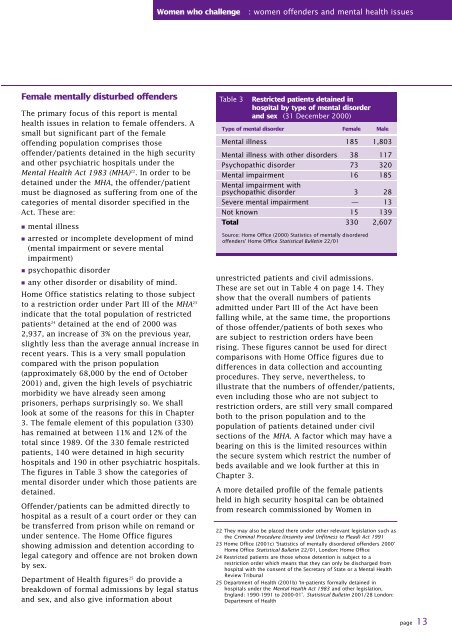Women who challenge - Nacro
Women who challenge - Nacro
Women who challenge - Nacro
- No tags were found...
Create successful ePaper yourself
Turn your PDF publications into a flip-book with our unique Google optimized e-Paper software.
<strong>Women</strong> <strong>who</strong> <strong>challenge</strong>: women offenders and mental health issuesFemale mentally disturbed offendersThe primary focus of this report is mentalhealth issues in relation to female offenders. Asmall but significant part of the femaleoffending population comprises thoseoffender/patients detained in the high securityand other psychiatric hospitals under theMental Health Act 1983 (MHA) 22 . In order to bedetained under the MHA, the offender/patientmust be diagnosed as suffering from one of thecategories of mental disorder specified in theAct. These are:• mental illness• arrested or incomplete development of mind(mental impairment or severe mentalimpairment)• psychopathic disorder• any other disorder or disability of mind.Home Office statistics relating to those subjectto a restriction order under Part III of the MHA 23indicate that the total population of restrictedpatients 24 detained at the end of 2000 was2,937, an increase of 3% on the previous year,slightly less than the average annual increase inrecent years. This is a very small populationcompared with the prison population(approximately 68,000 by the end of October2001) and, given the high levels of psychiatricmorbidity we have already seen amongprisoners, perhaps surprisingly so. We shalllook at some of the reasons for this in Chapter3. The female element of this population (330)has remained at between 11% and 12% of thetotal since 1989. Of the 330 female restrictedpatients, 140 were detained in high securityhospitals and 190 in other psychiatric hospitals.The figures in Table 3 show the categories ofmental disorder under which those patients aredetained.Offender/patients can be admitted directly tohospital as a result of a court order or they canbe transferred from prison while on remand orunder sentence. The Home Office figuresshowing admission and detention according tolegal category and offence are not broken downby sex.Department of Health figures 25 do provide abreakdown of formal admissions by legal statusand sex, and also give information aboutTable 3 Restricted patients detained inhospital by type of mental disorderand sex (31 December 2000)Type of mental disorder Female MaleMental illness 185 1,803Mental illness with other disorders 38 117Psychopathic disorder 73 320Mental impairment 16 185Mental impairment withpsychopathic disorder 3 28Severe mental impairment — 13Not known 15 139Total 330 2,607Source: Home Office (2000) Statistics of mentally disorderedoffenders’ Home Office Statistical Bulletin 22/01unrestricted patients and civil admissions.These are set out in Table 4 on page 14. Theyshow that the overall numbers of patientsadmitted under Part III of the Act have beenfalling while, at the same time, the proportionsof those offender/patients of both sexes <strong>who</strong>are subject to restriction orders have beenrising. These figures cannot be used for directcomparisons with Home Office figures due todifferences in data collection and accountingprocedures. They serve, nevertheless, toillustrate that the numbers of offender/patients,even including those <strong>who</strong> are not subject torestriction orders, are still very small comparedboth to the prison population and to thepopulation of patients detained under civilsections of the MHA. A factor which may have abearing on this is the limited resources withinthe secure system which restrict the number ofbeds available and we look further at this inChapter 3.A more detailed profile of the female patientsheld in high security hospital can be obtainedf rom re s e a rch commissioned by <strong>Women</strong> in22 They may also be placed there under other relevant legislation such asthe Criminal Procedure (Insanity and Unfitness to Plead) Act 199123 Home Office (2001c) ‘Statistics of mentally disordered offenders 2000’Home Office Statistical Bulletin 22/01, London: Home Office24 Restricted patients are those <strong>who</strong>se detention is subject to arestriction order which means that they can only be discharged fromhospital with the consent of the Secretary of State or a Mental HealthReview Tribunal25 Department of Health (2001b) ‘In-patients formally detained inhospitals under the Mental Health Act 1983 and other legislation,England: 1990-1991 to 2000-01’. Statistical Bulletin 2001/28 London:Department of Healthpage 13
















